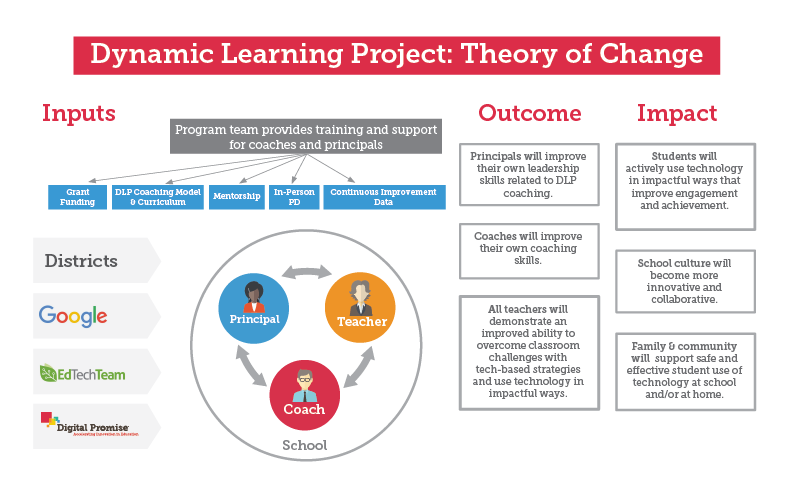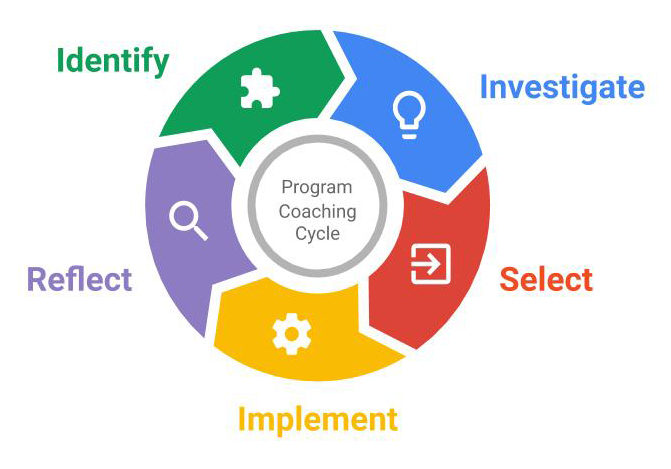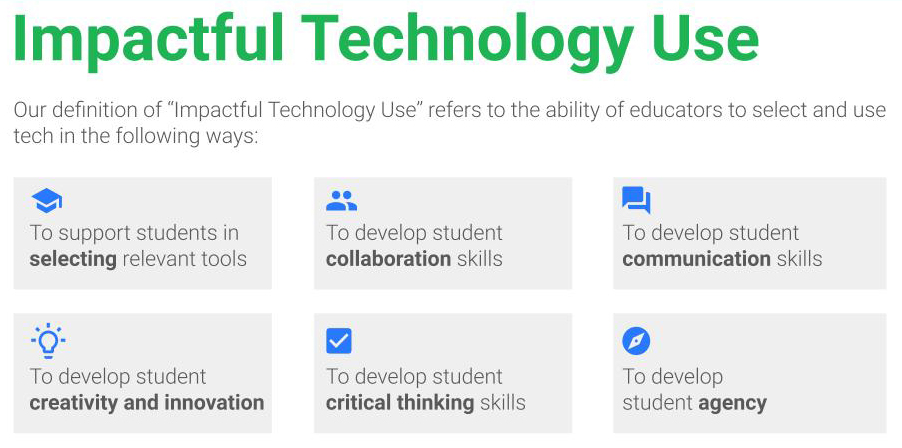
The Dynamic Learning Project pilot (DLP) believed that coaching is a partnership in which the coach, teacher, and administrator all work together for the success of the program. Teachers and coaches are co-owners of their close collaboration, and administrators nurture that co-ownership. In this way, full success of the collaboration is not possible without each partner playing their own role. As such, the DLP provided coaches and principals in participating schools with a defined challenge-based coaching model, sustained training, resources, and mentorship that helped them define and implement coaching as a partnership.
Coaching Model
As part of the DLP coaching model, coaches were recommended to segment each school year into four eight-week coaching cycles. In the three pilot years of the Dynamic Learning Project (2017-2020), the majority of teachers participated in one eight-week cycle; coaches worked with an average of nine teachers per cycle, allowing more than 1,100 teachers in 2017-2018 and 1,945 teachers in 2018-2019 to participate. The majority of teachers volunteered to participate in the DLP.

During each cycle, coaches provided each teacher with consistent personalized support through five steps in the DLP coaching model: (1) identify a classroom challenge(s) to be addressed; (2) brainstorm possible strategies; (3) select personalized strategies/tools; (4) implement selected strategies/tools in the classroom through co-teaching, modeling, and/or observation; and (5) reflect on progress.

Working with their coach, teachers learned how to use technology to address self-selected challenges that fell into eight categories: assessment, planning, classroom management, differentiation, engagement, content-based instructional strategies, developing students’ 21st century skills, and professional growth.
In using technology to address their challenge(s), coaches guided teachers in using technology in impactful ways. In the DLP, impactful technology use (ITU) was about using technology to develop students’ 21st century skills. Based on a review of existing scientific frameworks and measures for 21st century skills, we developed six indicators to define impactful technology use. These indicators have demonstrated excellent reliability in previous scientific studies. According to our framework, a teacher has used technology in an impactful way when they harness the tool to develop students’ collaboration, communication, creativity, and critical thinking skills, as well as their agency. For any of these outcomes to occur, first a teacher should be able to select relevant technology tools for the activity at hand and be able to develop their students’ ability to do the same.

Coaches and teachers in the DLP utilized the Impactful Technology Use rubric to guide their integration of technology into existing goals.
Sustained Training and Resources
DLP coaches, principals, and district administrators received varied forms of ongoing training and resources to learn how to successfully implement instructional technology coaching in their schools and districts. This began with a 3-5 day Summer Institute during which they received orientation on the DLP model, procedures, and expectations. Over the course of the year, coaches and principals continued their training through an online curriculum. This included modules that guided them through each stage of the coaching process, from launching the program at their schools to planning for the next school year. In addition, coaches participated in a book study and were provided a number of resources and tools to facilitate their work, including but not limited to an online Strategy Menu, protocols for collaborating with teachers, and access to a dashboard where they could record their coaching interactions. Coaches and principals also participated in both program-wide and regional communities of practice (PLCs). Finally, to facilitate the collection and analysis of school-level continuous improvement data, participating schools and districts were provided with access to teacher surveys and quarterly reports developed by the DLP researchers.
Mentorship
Beyond that, coaches and principals received sustained mentorship, which included participation in both DLP-wide and regional PLCs. Coach and principal met the mentor assigned to support their geographic region at the Summer Institute. Mentors were veteran coaches and teachers who supported both coaches and principals in the implementation of the program in their settings. Over the course of the year, mentors served the role of accessible experts who provided an outside perspective and personalized support to coaches and principals. After an initial school visit in the fall, mentors held frequent meetings with both coaches and principals. Coaches and principals reconvened with their mentor in person at regionally based Winter Institutes or fall visits to the school site.
As the immediate result of the Input, we hoped that DLP coaching could improve:
The final goal of DLP coaching was that students actively use technology in impactful ways that improve their 21st century skills and that ultimately improve their engagement and achievement. We also hoped to see change in school culture toward more innovation and collaboration among teachers. Finally, we hoped that school and district leaders amplified these impacts by sharing stories of coaching success with their greater community and by advocating for sustained coaching.
For data on outcomes and impact of the Dynamic Learning Project, visit our reports and resources.